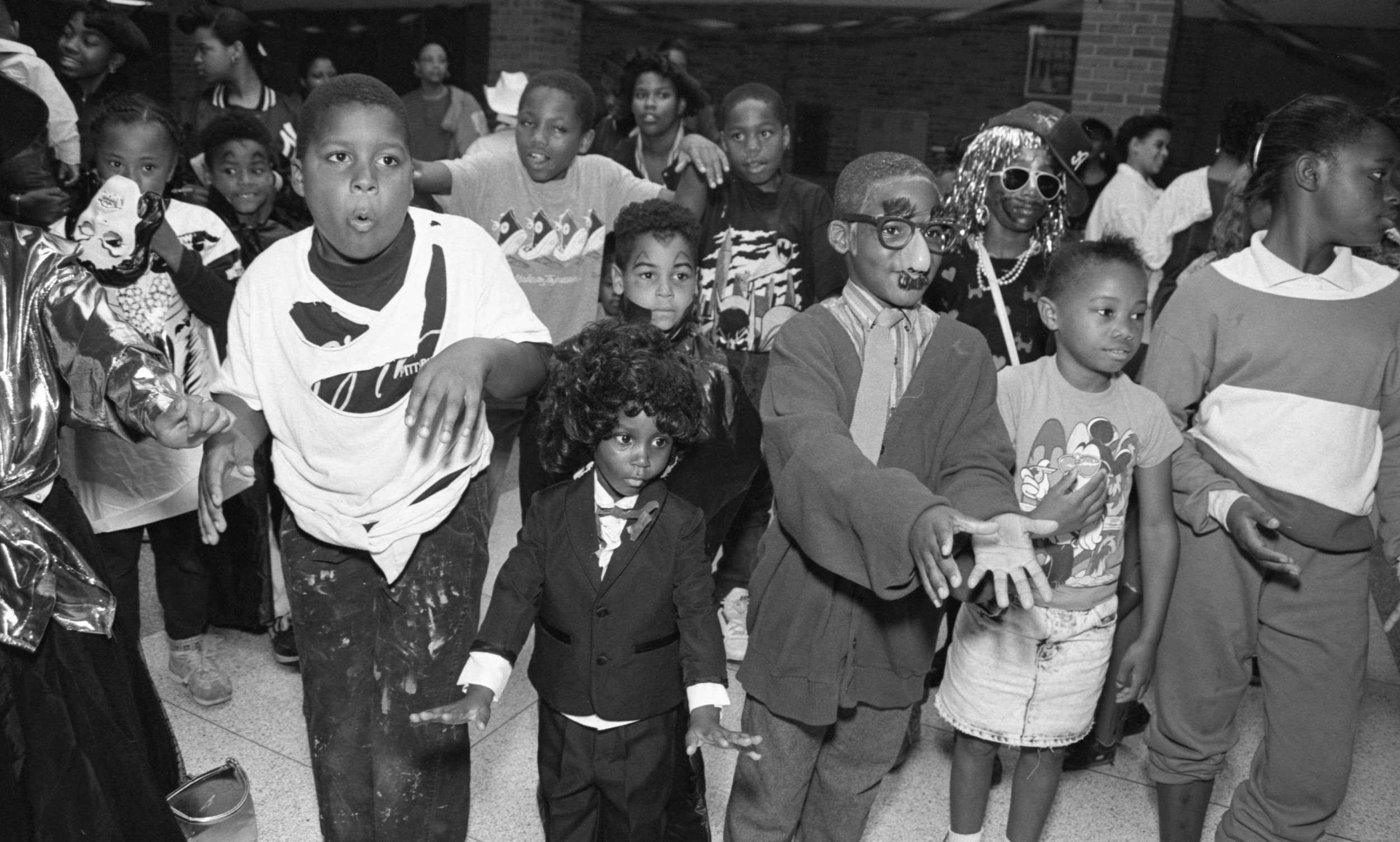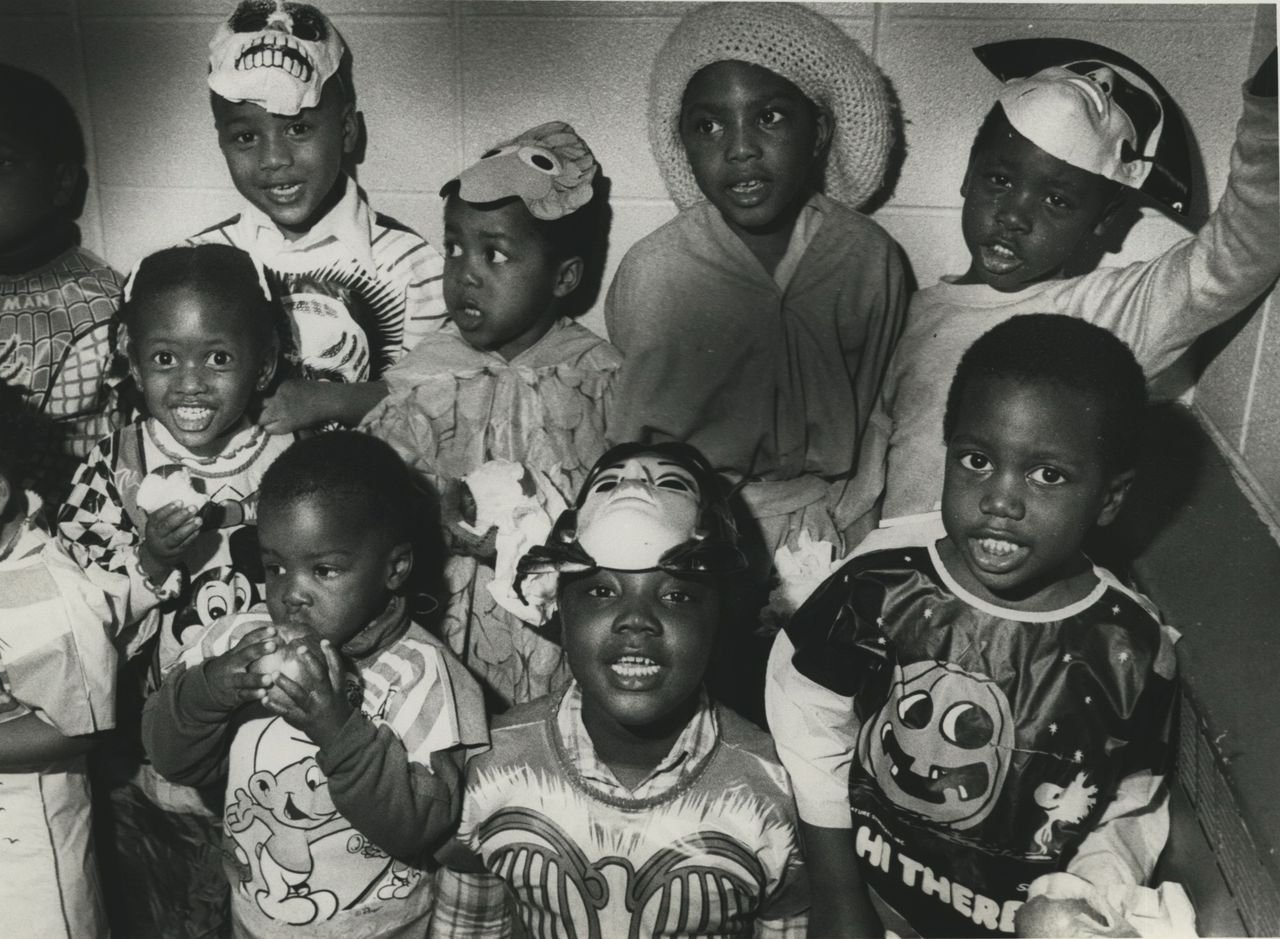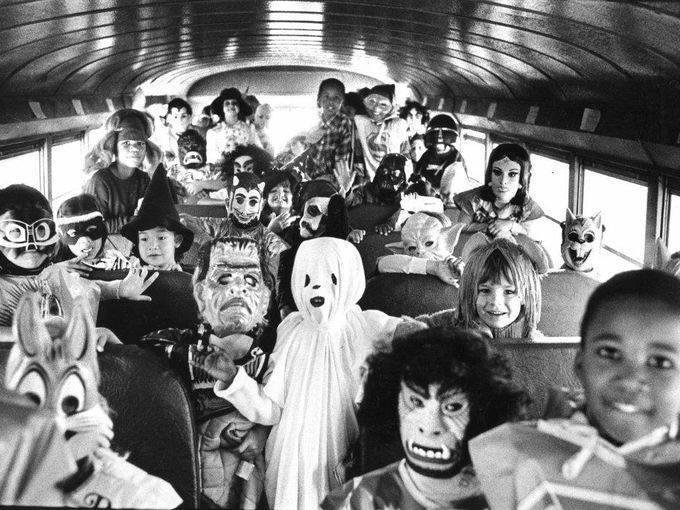Childhood Experiences of Halloween
Halloween or Hallows Eve happens only on one night, but it is one of the few holidays, other than Christmas, that young children tend to get most excited for. It typically ranges between the joys of dressing up or the eagerness to get free candy. Whatever the case might be, many individuals can recall the energy of excitement when the sun went down on October 31st of each year.
One of the most significant parts of Halloween is the costumes. Civil Rights Activist Fannie Rushing highlights this, “I loved Halloween, I loved getting dressed up in all the costumes.”
Program Administrator and Educator Loann Honesty King recalls a particular costume her mother got her, “I do remember one Halloween, my mother bought me a Halloween outfit, and it was supposed to be a shamrock, I suppose it was a shamrock, and it had the little green oilcloth shamrock for a hat and a lovely little white dress, fluffy with little shamrocks on it.”
Some take more creative liberty during Halloween, as highlighted by Education Consultant Adrienne Bailey, “... we would always wait to see what they would have as costumes; of course, in those days, people didn’t go out and buy costumes, so these were creatively made costumes, and they would typically dress up as women with outrageous getups that you could imagine.”
Radio Station Karen Slade recalls one time she “creatively” created her own costume, “like Halloween you’d dress up and I remember taking my mother’s sheets out cause I wanted to be a ghost and I cut holes in her new sheets because I needed eyes.”
Another aspect of Halloween is candy. Radio Personality La Donna Tittle says, “Halloween was the best time. Because you had sixteen apartments on one floor, and you had sixteen floors. So, multiplying that with the candy you would pick up for Halloween is tremendous.”
Publisher Rosalind Juanita Harris talks about how her family would utilize their Halloween candy, “....pillowcases full of candy, pillowcases, you know. My mother would take the candy, and it is distributed probably for the whole year. She’d take the candy – she’d take the candy and give a little bit. It was just our treats.”
Creator of Elmo and Puppeteer, Kevin Clash reminisces on the community aspect of Halloween, “...that was the fun thing about Halloween. You know, I think back then it was a whole neighborhood thing, the neighborhood we get involved, you know, some of the parents would go all out. You know with, with really make it like a haunted house and, and stuff, and they would really get a kick out of giving candy to everybody.”
This neighborhood unity is added upon by Reverend Dr. Barbra Reynolds, “I remember we used to go there and get candy apples on Halloween. It was a neighborhood where everybody knew everybody else.”
This is also explored by Documentary filmmaker Orlando Bagwell, “..Halloween, we’d open our house up, and all the kids would come in our house and come in our basement and hang out, you know. It was just like how you knew everybody…There was a great sense of camaraderie and a sense of community.”
Art Collector and Curator Patric McCoy have a similar experience, “..on Halloween, we would, we knew everybody on the block, so you and the kids were able to go by ourselves because there was, there was no fear cause everybody knew everybody, a community where adults looked after them, and to a point that you could give them one night where they could just run crazy, you know, and nobody would hurt them. Cause Halloween was a really, really special time for us when we could run the streets with our costumes and unescorted.”
While costume and candy are undoubtedly crucial for most kids, others had different experiences and traditions on the spooky holiday. Cleo F. Wilson, a nonprofit administrator and foundation executive for the Playboy Foundation, talks about other activities she would do besides trick’o treating, “...on Halloween night, they would show movies. They would project movies outside on the big screen, and there would be a bonfire I remember that the movie they were showing us was ‘The Invisible Man,’ and I don’t remember much about it except the fire and its dark all around us and this big, white screen and a chair rocking with nobody in it. That was just so scary for me.”
Associate Chief Executive and nonprofit chief executive Audrey Peeples shares other events that happened on Halloween night, “And at Halloween time they’d have a huge Halloween parade where you put on — your mother would make your Halloween outfit, and you would go down there….we would make lanterns and put candles - the lanterns made out of crepe paper, and we would put candles in the lantern, and we would have a lantern parade around the neighborhood, and the merchants would give the playground donuts and cider and stuff like that.” This playground carnival is not super uncommon, Physicist Wendell Hill adds, “on Halloween that the school's playgrounds had lots of activities for kids. And all the kids would come rather than do the trick-o treating. We go to this sort of carnival area that was set up for us. And so, that was a big big deal.”
As strange as it sounds for a child not to go trick-or-treating on Halloween, it was pretty standard for Nonprofit chief executive Jewell Jackson McCabe, “…I don’t remember going trick or treating ever because our - we had this great garden and great front porch, and she (mother) would hang, you know, all the paraphernalia, whether it be skeletons or the witches or whatever. And we’d all have jack-o-lanterns, which we’d all cut out, and we would go dunking for apples…. she melted many caramel to make those caramel apples. And it was a party.”
Halloween is what you make of it as a child, whether it be going trick-or-treating, making jack-o-lanterns, or going to a party or carnival, it was a time of enjoyment for many in their youth and an experience that many reflect fondly upon.
AMBASSADOR UPDATE: Hello, Everyone! It seems so crazy that I am nearing the end of my first semester, I feel like just yesterday, I was moving in to start my sophomore year. But nonetheless, I am incredibly excited about Thanksgiving! If you want to know more about the outreach I am doing at Spelman, please follow my Instagram page: @Spelman.Historymakers. There I will post updates on my blogs, quotes, and facts about different historymakers, as well as promotion for my future black history month contest.
SOURCES:
Jewell Jackson McCabe (The HistoryMakers A2007.181), interviewed by Adrienne Jones, June 20, 2007, The HistoryMakers Digital Archive. Session 2, tape 8, story 6, Jewell Jackson McCabe describes her family's food traditions
Karen Slade (The HistoryMakers A2014.213), interviewed by Larry Crowe, July 28, 2014, The HistoryMakers Digital Archive. Session 1, tape 1, story 9, Karen Slade remembers the Lee-Miles neighborhood of Cleveland, Ohio
Wendell Hill (The HistoryMakers A2012.226), interviewed by Larry Crowe, September 12, 2012, The HistoryMakers Digital Archive. Session 1, tape 2, story 4, Wendell Hill talks about his childhood church, friends and social activities
Adrienne Bailey (The HistoryMakers A2008.121), interviewed by Larry Crowe, November 4, 2008, The HistoryMakers Digital Archive. Session 1, tape 1, story 5, Adrienne Bailey describes her mother's childhood
Patric McCoy (The HistoryMakers A2008.129), interviewed by Thomas Jefferson, November 7, 2008, The HistoryMakers Digital Archive. Session 1, tape 2, story 3, Patric McCoy describes his childhood neighborhood in Chicago, Illinois
Fannie Rushing (The HistoryMakers A2003.288), interviewed by Larry Crowe, December 5, 2003, The HistoryMakers Digital Archive. Session 1, tape 2, story 3, Fannie Rushing describes the sights, sounds and smells of her childhood in Hyde Park, Chicago, Illinois
Loann Honesty King (The HistoryMakers A2008.014), interviewed by Cheryl Butler, February 6, 2008, The HistoryMakers Digital Archive. Session 1, tape 1, story 9, Loann Honesty King remembers her shamrock Halloween costume
Reverend Dr. Barbara Reynolds (The HistoryMakers A2005.156), interviewed by Larry Crowe, June 30, 2005, The HistoryMakers Digital Archive. Session 1, tape 2, story 1, Reverend Dr. Barbara Reynolds describes the sights, sounds and smells of her childhood
La Donna Tittle (The HistoryMakers A2003.041), interviewed by Larry Crowe, March 17, 2003, The HistoryMakers Digital Archive. Session 1, tape 1, story 12, La Donna Tittle describes living in Robert Taylor Homes as a youth
Kevin Clash (The HistoryMakers A2007.268), interviewed by Adrienne Jones, September 21, 2007, The HistoryMakers Digital Archive. Session 1, tape 1, story 10, Kevin Clash remembers the holidays with his family
Barbara Heineback (The HistoryMakers A2005.181), interviewed by Jodi Merriday, August 2, 2005, The HistoryMakers Digital Archive. Session 1, tape 2, story 7, Barbara Heineback remembers neighbors from her childhood in Port Washington, New York
Rosalind Juanita Harris (The HistoryMakers A2008.125), interviewed by Denise Gines, November 5, 2008, The HistoryMakers Digital Archive. Session 1, tape 2, story 3, Rosalind Juanita Harris remembers the holidays
Orlando Bagwell (The HistoryMakers A2007.339), interviewed by Adrienne Jones, December 17, 2007, The HistoryMakers Digital Archive. Session 1, tape 3, story 8, Orlando Bagwell describes the Wilson Park neighborhood of Baltimore, Maryland
Audrey Peeples (The HistoryMakers A2003.203), interviewed by Larry Crowe, August 25, 2003, The HistoryMakers Digital Archive. Session 1, tape 1, story 11, Audrey Peeples describes her childhood activities and interests
Cleo F. Wilson (The HistoryMakers A2010.100), interviewed by Larry Crowe, August 25, 2010, The HistoryMakers Digital Archive. Session 1, tape 1, story 11, Cleo F. Wilson describes her earliest childhood memory





